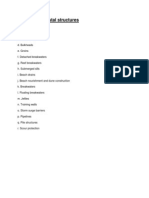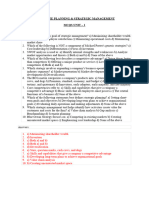LAB 2 Linear Motion
LAB 2 Linear Motion
Uploaded by
syazwanshapawiCopyright:
Available Formats
LAB 2 Linear Motion
LAB 2 Linear Motion
Uploaded by
syazwanshapawiOriginal Description:
Copyright
Available Formats
Share this document
Did you find this document useful?
Is this content inappropriate?
Copyright:
Available Formats
LAB 2 Linear Motion
LAB 2 Linear Motion
Uploaded by
syazwanshapawiCopyright:
Available Formats
LAB 2 : LINEAR MOTION
OBJEKTIVE
1. To analyze linear motion of moving object.
2. To determine displacement, velocity and acceleration of a linear motion.
INFERENCE
1. Linear motion is a motion along a straight line.
2. Velocity is uniform when acceleration is zero and non-uniform when acceleration is
non zero.
HYPOTHESIS
1. Velocity is speed in a given direction.
2. Acceleration is the increase of velocity over a period of time.
3. Deceleration is the decrease of velocity over a period of time.
APPARATUS
1. Ticker tape
2. Runway
3. Power supply
4. Trolley
5. Jumper wire
6. Ticker timer
PROCEDURE
1. The apparatus was set up as figure 1.
2. The runway is inclined about 1m 2m, so that trolley will roll down freely from rest
without any force.
3. The ticker tape was attached to the trolley using cellophane tape.
4. Switch on the ticker timer and released the trolley freely.
Figure 1
RESULT
1 Number of 10-dot strips 5
2 Total time, t total = number of strips 0.2 1.0 s
3 Total of displacement of the trolley 65.2 m
4 Average velocity of the trolley
v = total displacement
total time
65.2 m/s
5 Acceleration of the trolley
a. Initial velocity
u = length of first strip
time for 10-dots
16 m/s
b. Final velocity
v = length of last strip
time of 10-dots
115 m/s
c. Time of acceleration, t
(number of strip 1) ( time of 10 dots )
0.8 s
d. Acceleration
a = v - u
t
123.75 m/
6 Average velocity
V average = v + u
t
65.5 m/s
CALCULATION
ANALYSIS
1. The 10 dot was mark and number as the figure above.
2. The ticker tape was cut and paste into 10-dot strips on the graph paper.
Note:
1. Frequency of ticker time is 50Hz. Therefore, 1 dot or 1 unit time represents 1/50seconds or
0.02 second.
2. Time for 10 dots = 10 dots x 0.02 second = 0.2 seconds
ERROR ANALYSIS
Error
1. Careless when doing the calculation.
2. Applied force when release the trolley.
Step to avoid error
1. Be careful when doing the calculation.
2. Make sure there is no applied force when release the trolley.
QUESTION
Yes have different, the different between Result 4 and 6 is result 4 is 65.2 m/s and result 6 is
65.5 m/s. That because result 4 is a theory while result 6 is practical. Result 4 is theory
because it shows the velocity of the experiment. While result 6 shows the average velocity.
CONCLUSION
From the experiment, we found that experiment linear motion was successful done according
to the procedures.
The objective of experiment was achieved to analyze linear motion of a moving object and
determine displacement, velocity and acceleration of a linear motion.
As the conclusion, the hypothesis is accepted. We enable to determine linear motion of a
moving object and enable to determine displacement, velocity and acceleration of linear
motion.
You might also like
- AmpliTube 5 User ManualDocument99 pagesAmpliTube 5 User Manualbarroquista80% (5)
- VectorsDocument5 pagesVectorsDiwa Liwliw100% (1)
- Ormeryll Ilse Ornest Muhammad Imran Bin Yusoff Amirah Nabilah Binti Shan Azmawi Nur Sharsabella Binti Norasri Kasriansyah Bin RullyDocument53 pagesOrmeryll Ilse Ornest Muhammad Imran Bin Yusoff Amirah Nabilah Binti Shan Azmawi Nur Sharsabella Binti Norasri Kasriansyah Bin RullyJezzebel JuniorNo ratings yet
- MT ProcedureDocument9 pagesMT ProcedureTouil Houssem100% (1)
- Homer - Odyssey (Trans. Merrill)Document430 pagesHomer - Odyssey (Trans. Merrill)Zach Childress100% (5)
- Lab Report Phy210 - Mac 2021 - Ogos 2021Document8 pagesLab Report Phy210 - Mac 2021 - Ogos 2021Yuu ShaNo ratings yet
- Matriculation Physics Experiment 5 (Malaysia)Document6 pagesMatriculation Physics Experiment 5 (Malaysia)Muhammad Syahir Asyraf0% (3)
- Lab Report Exp 2Document7 pagesLab Report Exp 2jamesNo ratings yet
- Science Enginering Lab Report - Experiment 2 (Liner Motion)Document3 pagesScience Enginering Lab Report - Experiment 2 (Liner Motion)Q Hydar Q Hydar33% (3)
- Physic Lab Report Exp.5 Simple Harmonic MotionDocument14 pagesPhysic Lab Report Exp.5 Simple Harmonic Motioniqmalaqish05No ratings yet
- Physics Lab ReportDocument8 pagesPhysics Lab ReportNurul Hasanah75% (4)
- Matriculation Physics Experiment 2 (Malaysia)Document5 pagesMatriculation Physics Experiment 2 (Malaysia)Muhammad Syahir Asyraf67% (9)
- Density of A Glass BlockDocument4 pagesDensity of A Glass BlockMichael Timson0% (1)
- Experiment 2Document6 pagesExperiment 2Syahmi RifqiNo ratings yet
- Muet Model EssaysDocument28 pagesMuet Model Essays2022834672No ratings yet
- Lab Report Mass Spring System Omar Nizar2Document31 pagesLab Report Mass Spring System Omar Nizar2Omar MustafaNo ratings yet
- Test 1 - Set 1 - PHY150Document4 pagesTest 1 - Set 1 - PHY150liliNo ratings yet
- Series Parallel Lab ReportDocument3 pagesSeries Parallel Lab ReportMitch Gramazio20% (5)
- Labsheet Linear MotionDocument6 pagesLabsheet Linear MotionGnabryNo ratings yet
- Exp 3Document8 pagesExp 3ValentinoDullSatinNo ratings yet
- Form 4 Additional Mathematics Chapter 6 Coordinate GeometryDocument14 pagesForm 4 Additional Mathematics Chapter 6 Coordinate GeometryManisha Sekaran Muniandy0% (1)
- Experiment 2 SKF3013Document9 pagesExperiment 2 SKF3013Nurfariha SafarNo ratings yet
- Form 5 Chapter 3Document46 pagesForm 5 Chapter 3qq23571% (7)
- Physics Paper 2 SF 026/2 PSPSM Semester 2 Session 2013/2014Document11 pagesPhysics Paper 2 SF 026/2 PSPSM Semester 2 Session 2013/2014Fun Fun Tik TokNo ratings yet
- F4 ExperimentsDocument52 pagesF4 ExperimentsKiTTy94% (16)
- Physics Form 4Document10 pagesPhysics Form 4Woody CysNo ratings yet
- Uniform Circular Motion: Lab ReportDocument11 pagesUniform Circular Motion: Lab Reportapi-439202411No ratings yet
- Experiment 2Document5 pagesExperiment 2Alya HaifaNo ratings yet
- Measuring Speed of SoundDocument3 pagesMeasuring Speed of SoundMangJoseNo ratings yet
- EXPERIMENT 3 - Lab ReportDocument6 pagesEXPERIMENT 3 - Lab ReportSheikh BajunaidNo ratings yet
- Tutorial 1 PHY150 - Answer PDFDocument10 pagesTutorial 1 PHY150 - Answer PDFmasyaNo ratings yet
- Phy 110 Lab Report 1Document6 pagesPhy 110 Lab Report 1Wilbert WanNo ratings yet
- F5 ExperimentsDocument27 pagesF5 ExperimentsNarend Gunner80% (5)
- Linear MotionDocument4 pagesLinear MotionMohd Nuh25% (4)
- Edexcel IGCSE Physics Revision Note1Document52 pagesEdexcel IGCSE Physics Revision Note1nazli fathimaNo ratings yet
- E102 KinematicsDocument8 pagesE102 KinematicsKenneth PeraNo ratings yet
- Linear MotionDocument9 pagesLinear MotionShanti Thanarajan33% (3)
- AnalysisDocument8 pagesAnalysisCatherine N. CapalosNo ratings yet
- Cambridge Kinematics EssayDocument12 pagesCambridge Kinematics EssaySuresh SenanayakeNo ratings yet
- Chapter 2 Linear and MotionDocument45 pagesChapter 2 Linear and MotionYoga RajNo ratings yet
- Form 4 Physics Chapter 2.1 2.2Document22 pagesForm 4 Physics Chapter 2.1 2.2Samuel LiewNo ratings yet
- F4experiments 120222235933 Phpapp02Document52 pagesF4experiments 120222235933 Phpapp02Syafiq HazwanNo ratings yet
- NewtonDocument12 pagesNewtonapi-327712007No ratings yet
- Labsheet Linear MotionDocument6 pagesLabsheet Linear MotionGnabryNo ratings yet
- Sahriani-Laporan Gerak Lurus (English)Document24 pagesSahriani-Laporan Gerak Lurus (English)aekimNo ratings yet
- Diagnostic Test Dynamcis. DIAGNOSTIC TEST QUESTION ONLYDocument10 pagesDiagnostic Test Dynamcis. DIAGNOSTIC TEST QUESTION ONLYAngelica RoseNo ratings yet
- NOTES - MOTION AND TIME CLASS VIIsahfghfjfgjhfgDocument8 pagesNOTES - MOTION AND TIME CLASS VIIsahfghfjfgjhfgForex lolNo ratings yet
- مختبر الفيزياء الطبية - pendulumDocument6 pagesمختبر الفيزياء الطبية - pendulumm9ngmnsxp4No ratings yet
- Chapter 2 PhysicsDocument20 pagesChapter 2 PhysicsDiveiya KajentheranNo ratings yet
- Physics Lab ReportDocument6 pagesPhysics Lab Reporttanveer111222333No ratings yet
- Experiment On Simple Pendulum 1 1Document5 pagesExperiment On Simple Pendulum 1 1JeyelNo ratings yet
- Analysis of MotionDocument5 pagesAnalysis of MotionDong Chooi YingNo ratings yet
- PDF2Document24 pagesPDF2testsax.314No ratings yet
- F4 CHP2 Dist Disp AccDocument7 pagesF4 CHP2 Dist Disp AccKevin DanyNo ratings yet
- Rectilinear MotionDocument36 pagesRectilinear MotionYola Ivonny HariantoNo ratings yet
- Diagnostic Test DynamcisDocument13 pagesDiagnostic Test DynamcisJames TyNo ratings yet
- Simple Harmonic MotionDocument6 pagesSimple Harmonic MotionnorllizaNo ratings yet
- Physics Lab ReportDocument6 pagesPhysics Lab ReportTotako MatsuNo ratings yet
- E102 Analysis and ConclusionDocument12 pagesE102 Analysis and ConclusionAnizza Marie SakilanNo ratings yet
- 6 Velocity-AccelerationDocument32 pages6 Velocity-AccelerationJohnpatrick CiaNo ratings yet
- PHYE102Document14 pagesPHYE102Ricardo LunaNo ratings yet
- IB Physics Circular MotionDocument13 pagesIB Physics Circular MotionSmartPurdy100% (1)
- Applications of Derivatives Rate of Change (Calculus) Mathematics Question BankFrom EverandApplications of Derivatives Rate of Change (Calculus) Mathematics Question BankNo ratings yet
- Symmetricsds User GuideDocument170 pagesSymmetricsds User Guidegloubi1977No ratings yet
- 16.0 ANSYS Quick Start Installation GuideDocument4 pages16.0 ANSYS Quick Start Installation GuidemuomemoNo ratings yet
- J Z Y Z Z: Section 7.9 Laplace's Equation in A Circular CylinderDocument11 pagesJ Z Y Z Z: Section 7.9 Laplace's Equation in A Circular CylinderSalam AlbaradieNo ratings yet
- Getting Off The Hedonic Treadmill Double Entry JournalDocument2 pagesGetting Off The Hedonic Treadmill Double Entry Journalapi-316576650No ratings yet
- Week 3 HRMDocument6 pagesWeek 3 HRMIsha LarionNo ratings yet
- Assessment Tool PPSSHDocument2 pagesAssessment Tool PPSSHMARJORIE LANORIO100% (2)
- PrEd161n Assessment 3.1 Genove Verna BsEd-2Document2 pagesPrEd161n Assessment 3.1 Genove Verna BsEd-2Castrodes Ma Meca Grace100% (1)
- The Rise of Identity in SLA Research Pos PDFDocument14 pagesThe Rise of Identity in SLA Research Pos PDFImdad KhanNo ratings yet
- Talend Interview QuestionsDocument5 pagesTalend Interview Questionskeerthana babuNo ratings yet
- Off The Wall WordDocument2 pagesOff The Wall WordsanjabiljNo ratings yet
- Load Estimation in BuildingsDocument21 pagesLoad Estimation in BuildingsKo Pauk100% (1)
- RCC Box Culvert Methodology and Designs Including Computer MethodDocument37 pagesRCC Box Culvert Methodology and Designs Including Computer MethodKent HernandoNo ratings yet
- Photo NotesDocument21 pagesPhoto NotesNicole Marie Tan PosadasNo ratings yet
- Latest Free 100-105 Exam Questions With Valid 100-105 DumpsDocument9 pagesLatest Free 100-105 Exam Questions With Valid 100-105 DumpsJasmine popyNo ratings yet
- OralCare OrthoCatalog 70-2021-3851-0 - eDocument232 pagesOralCare OrthoCatalog 70-2021-3851-0 - eDr HuanNo ratings yet
- Location and Site Plan: JS ELDocument1 pageLocation and Site Plan: JS ELStephany PolinarNo ratings yet
- Rosicrucian ClubsDocument13 pagesRosicrucian Clubstotheken100% (1)
- Manual Do UsuarioDocument19 pagesManual Do UsuarioJonathan Jr OliveiraNo ratings yet
- Types of Coastal StructuresDocument18 pagesTypes of Coastal StructuresMourad Nadeer100% (1)
- We Said Feminist Fairy Tales, Not Fractured Fairy Tales!Document5 pagesWe Said Feminist Fairy Tales, Not Fractured Fairy Tales!Zhu KristinaNo ratings yet
- PSD Impt QuestionsDocument8 pagesPSD Impt QuestionsDIPESHNo ratings yet
- KF 500 - KF 50: As Close To Reality As You Can GetDocument4 pagesKF 500 - KF 50: As Close To Reality As You Can Gettystar_21No ratings yet
- Strategic Management Mcqs Unit 1Document15 pagesStrategic Management Mcqs Unit 1Hemant Kumar AhirwarNo ratings yet
- Geometry, Vol.5 - Minimal Surfaces (Ed. Osserman) (EMS 90)Document139 pagesGeometry, Vol.5 - Minimal Surfaces (Ed. Osserman) (EMS 90)api-379872950% (2)
- Accounts Payables SOP Mar'22Document134 pagesAccounts Payables SOP Mar'22AndyTanNo ratings yet
- 1 s2.0 S0305440313003300 MainDocument12 pages1 s2.0 S0305440313003300 MainStefan GhidiuNo ratings yet
- Hamza Project On Marketing of Mineral Water BiDocument67 pagesHamza Project On Marketing of Mineral Water Binayaksj1987No ratings yet

























































































